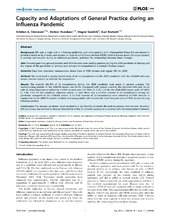| dc.contributor.author | Simonsen, Kristian Anton | en_US |
| dc.contributor.author | Hunskår, Steinar | en_US |
| dc.contributor.author | Sandvik, Hogne | en_US |
| dc.contributor.author | Rørtveit, Guri | en_US |
| dc.date.accessioned | 2015-07-03T08:55:53Z | |
| dc.date.available | 2015-07-03T08:55:53Z | |
| dc.date.issued | 2013-07-18 | |
| dc.identifier.issn | 1932-6203 | |
| dc.identifier.uri | https://hdl.handle.net/1956/10117 | |
| dc.description.abstract | Background: GPs play a major role in influenza epidemics, and most patients with influenza-like-illness (ILI) are treated in general practice or by primary care doctors on duty in out-of-hours services (OOH). Little is known about the surge capacity in primary care services during an influenza pandemic, and how the relationship between them changes. Aim: To investigate how general practice and OOH services were used by patients during the 2009 pandemic in Norway and the impact of the pandemic on primary care services in comparison to a normal influenza season. Materials: Data from electronic remuneration claims from all OOH doctors and regular GPs for 2009. Methods: We conducted a registry-based study of all ILI consultations in the 2009 pandemic with the 2008/09 influenza season (normal season) as baseline for comparison. Results: The majority (82.2%) of ILI consultations during the 2009 pandemic took place in general practice. The corresponding number in the 2008/09 season was 89.3%. Compared with general practice, the adjusted odds ratio for ILI with all other diagnoses as reference in OOH services was 1.23 (95% CI, 1.18, 1.27) for the 2008/2009 season and 1.87 (95% CI, 1.84, 1.91) for the pandemic influenza season. In total there was a 3.3-fold increase in ILI consultations during the pandemic compared to the 2008/09 season. A 5.5-fold increase of ILI consultations were observed in OOH services in comparison to the 2008/09 season. Children and young adults with ILI were the most frequent users of OOH services during influenza periods. Conclusions: The autumn pandemic wave resulted in a significantly increased demand on primary care services. However, GPs in primary care services in Norway showed the ability to increase capacity in a situation with increased patient demand. | en_US |
| dc.language.iso | eng | eng |
| dc.publisher | PLOS | eng |
| dc.relation.ispartof | <a href="http://hdl.handle.net/1956/10119" target="blank">The 2009 influenza pandemic in primary care. Clinical manifestations, attitudes and utilisation of services</a> | |
| dc.rights | Attribution CC BY | eng |
| dc.rights.uri | http://creativecommons.org/licenses/by/3.0/ | eng |
| dc.title | Capacity and Adaptations of General Practice during an Influenza Pandemic | en_US |
| dc.type | Peer reviewed | |
| dc.type | Journal article | |
| dc.description.version | publishedVersion | en_US |
| dc.rights.holder | Copyright 2013 Simonsen et al. | |
| dc.source.articlenumber | e69408 | |
| dc.identifier.doi | https://doi.org/10.1371/journal.pone.0069408 | |
| dc.identifier.cristin | 1040986 | |
| dc.source.journal | PLoS ONE | |
| dc.source.40 | 8 | |
| dc.source.14 | 7 | |
| dc.subject.nsi | VDP::Medisinske Fag: 700::Klinisk medisinske fag: 750::Allmennmedisin: 751 | en_US |

